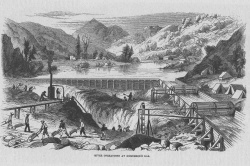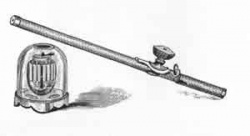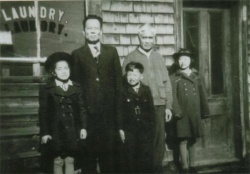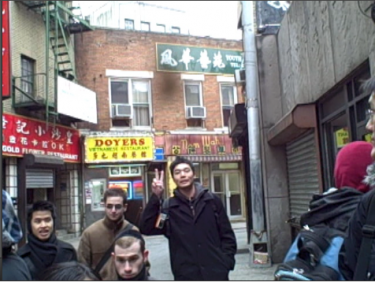From The Peopling of New York City
Contents |
The Starters of Chinese Business in New York
Ah Sue
During the 1800’s, there was much trade that took place in New York, since it was a coastline with many ports open to merchants from overseas looking to bargain and make profit. But with all the sailing overseas there was also ships meant for travel. Ah Sue was a young man who worked for a Hong Kong-New York packet line, he served as a cook and steward to Asian travelers and others who set sail on the ship. After working for as a sailor, cook, and steward, he grew weary of sea and of the maritime traveling. So, in 1847, he opened a small store on Cherry Street that sold tobacco and candy. Along with this small store he has a small boarding house business that served as temporary homes for the Chinese, Japanese, Filipino, Hindu, Maori, Hawaiian, Malay, and Anamneses seamen that docked their ships a few blocks away. [1]
Quimbo Appo
A little different from the approach that Ah Sue took, there was a man named Quimbo Appo who was at the other end of the Chinese spectrum of class. He was a man who took to trade routes as a merchant after surviving the British bombing of Shanghai during the Opium War. But after growing tired of the trade routes, he decided to test his luck in California with the Gold Rush. After the Gold Rush, he moved to New York and opened a small retail store in Spring Street selling tea. Tea was the major Chinese import due to the fact Chinese tea was considered exquisite and high quality compared to teas imported from other regions, silk was also a major export that was popular for the texture. Appo mastered English speech and other necessities in America as many of the other merchants did in order to do business.
Companionship is something of great importance in life and often a spouse would fill that need. But with no Chinese women in town, the Chinese men married local women, as did Appo. About a fourth to a third of the residential Chinese men married local women. Appo married a young Irish-American Catherine Fitzpatrick, but this was something that was not of surprise during this time. The marriage between an Irish “apple women” and an Asian cigar peddler was common, but this union of different ethnicities created racial conflicts with white men who were racist against the Chinese. Unlike the anxiety that rose from black-white relationships, the conflicts that rose where not that large in scale and this was due to the small population of Chinese during the time. [2]
Wo Kee
A Hong Kong merchant named Wo Kee moved his general goods store from Oliver to Mott in 1872, creating the first commercial anchor in the area that would be known as Chinatown.[3]
Wo Kee’s general good store was filled with an array of goods crammed into the front and back rooms. There was Chinese medicines, incense sticks, jade bracelets, dried shark fins, ducks split and baked in peanut oil, opium and pipes for smoking it, silks, and exquisite teas. In 1872, Wo Kee’s establishment also played a role as a social club and a center for entertainment. The establishment was used to pick up mail, get tips on work opportunities, while the basement allowed for gambling, lounging, and eating. The upstairs of the establishment was used as sleeping quarters and used for cigar making.[4]
They call me "John Chinaman"
John Chinaman, a common name used for the Chinese men who have went from being seamen into land laborers, usually in hopes of making a fortune and returing to China. But the name John Chinaman was not created from the few Chinese that owned small shops near the harbor. After Ah Sue, there were more boardinghouses that emerged to host the men who switched to land laborers but work was difficult to find for these new Chinese immigrants. So, they resorted to selling Chinese candies and peddling cigars around City Hall Park and the Bowery, becoming a familiar figure in the area they obtained the nickname John Chinaman. [5]
The Laundry Business
In 1877, only about 30 Chinese men where in the laundry business, also known as the “washee washees.” But in 1879, the numbers jumped to two hundred hand laundries in Manhattan and in 1888 the number multiplied to two thousand such laundries in Manhattan, not to mention an additional nine hundred in Brooklyn.[6]
Why did most the Chinese open hand laundry is an often asked question and many believe it was because they were unknowledgeable. But the reason the Chinese picked this occupation was due to the prejudice against them in New York and it was difficult for them to find other jobs. Another reason why this business became so popular was because it was a method of making money surely and quickly, where the price to start-up was minimal and simple. The average laundryman managed to save up to fifteen hundred to two thousand dollars and sold their business to relatives coming in from the West Coast or Hong Kong. After making the money, they would use it to return home to China, back to their families. [7]
Miscellaneous
During the 1890s, for the Chinese men living in Chinatown, many of them were cigar makers or merchants. But there were clerks, barbers, doctors, and professional gamblers as well. Many Chinese men were hired as servants in the uptown rich mansions as well, replacing unmanageable Irish girls.[8] An interesting job some Chinese would take part in is as a mourner. During the funeral, mourners would be hired to cry and show their presence for the dead.
Non Wah Tea House
Non Wah Tea House[9]Contemporary Times
- Return to Occupational Patterns
- Return to Chinese
References
- ↑ Burrows, Edwin G., and Mike Wallace. Gotham. A History of New York City to 1898. Oxford UP, 1998. (page 1127)
- ↑ Burrows, Edwin G., and Mike Wallace. Gotham. A History of New York City to 1898. Oxford UP, 1998. (page 1127)
- ↑ Burrows, Edwin G., and Mike Wallace. Gotham. A History of New York City to 1898. Oxford UP, 1998. (Page 1127)
- ↑ Burrows, Edwin G., and Mike Wallace. Gotham. A History of New York City to 1898. Oxford UP, 1998. (Page 1127-1128)
- ↑ Burrows, Edwin G., and Mike Wallace. Gotham. A History of New York City to 1898. Oxford UP, 1998. (page 1127)
- ↑ Burrows, Edwin G., and Mike Wallace. Gotham. A History of New York City to 1898. Oxford UP, 1998. (Page 1128)
- ↑ Burrows, Edwin G., and Mike Wallace. Gotham. A History of New York City to 1898. Oxford UP, 1998. (Page 1128)
- ↑ Burrows, Edwin G., and Mike Wallace. Gotham. A History of New York City to 1898. Oxford UP, 1998. (Page 1128)
- ↑ Big Onion Tours, Guide: Jenna
- ↑ Big Onion Tours, Guide: Jenna



